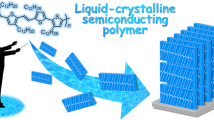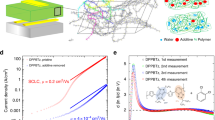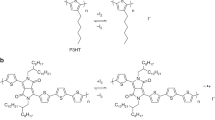Abstract
The electrical and optical properties of conjugated polymers have received considerable attention in the context of potentially low-cost replacements for conventional metals and inorganic semiconductors. Charge transport in these organic materials has been characterized in both the doped-metallic and the semiconducting state1,2,3,4, but superconductivity has not hitherto been observed in these polymers. Here we report a distinct metal–insulator transition and metallic levels of conductivity in a polymer field-effect transistor. The active material is solution-cast regioregular poly(3-hexylthiophene), which forms relatively well ordered films owing to self-organization, and which yields a high charge carrier mobility (0.05–0.1 cm2 V-1 s-1) at room temperature. At temperatures below ∼2.35 K with sheet carrier densities exceeding 2.5 × 1014 cm-2, the polythiophene film becomes superconducting. The appearance of superconductivity seems to be closely related to the self-assembly properties of the polymer, as the introduction of additional disorder is found to suppress superconductivity. Our findings therefore demonstrate the feasibility of tuning the electrical properties of conjugated polymers over the largest range possible—from insulating to superconducting.
This is a preview of subscription content, access via your institution
Access options
Subscribe to this journal
Receive 51 print issues and online access
$199.00 per year
only $3.90 per issue
Buy this article
- Purchase on Springer Link
- Instant access to full article PDF
Prices may be subject to local taxes which are calculated during checkout




Similar content being viewed by others
References
Chiang, C. K. et al. Electrical conductivity in doped polyacetylene. Phys. Rev. Lett. 39, 1098–1101 (1977).
Skotheim, T. A., Elsenbaumer, R. L. & Reynolds, J. R. (eds) Handbook of Conjugated Polymers (Marcel Dekker, New York, 1996).
Mark, J. (ed.) Physical Properties of Polymers Handbook (AIP Press, New York, 1996).
Nalwa, H. S. Handbook of Organic Conductive Molecules and Polymers (Wiley, Chichester, 1997).
Aleshin, A., Kiebooms, R., Reghu, M. & Heeger, A. J. Electronic transport in doped poly(3,4-ethylenedioxythiophene) near the metal-insulator transition. Synth. Met. 90, 61–68 (1997).
Ahlskog, M. & Menon, R. Charge transport in conducting polymers near the critical and insulating regimes. Phys. Status Solidi B 205, 305–310 (1998).
Kim, J. H. et al. Structural aspects of metal-insulator transition in doped conducting polymers. Synth. Met. 84, 71–72 (1997).
Masubuchi, S. & Kazama, S. Intrinsic transport properties in electrochemically prepared polythiophene doped with PF-6. Synth. Met. 74, 151–158 (1995).
Bao, Z., Dodabalapur, A. & Lovinger, A. J. Soluble and processable regioregular poly(3-hexylthiophene) for thin film field-effect transistor applications with high mobility. Appl. Phys. Lett. 69, 4108–4110 (1996).
Sirringhaus, H. et al. Two-dimensional charge transport in self-organized, high-mobility conjugated polymers. Nature 401, 685–688 (1999).
Österbacka, R., An, C. P., Jiang, X. M. & Vardeny, Z. V. Two-dimensional electronic excitations in self-assembled conjugated polymer nanocrystals. Science 287, 839–842 (2000).
McCullogh, R. D., Tristramnagle, S., Williams, S. P., Lowe, R. D. & Jayaraman, M. Self-orienting head-to-tail poly(3-alkylthiophenes)—New insights on structure-property relationship in conducting polymers. J. Am. Chem. Soc. 115, 4910–4911 (1993).
Sirringhaus, H., Tessler, N. & Friend, R. H. Integrated optoelectronic devices based on conjugated polymers. Science 280, 1741–1744 (1998).
Dodabalapur, A. et al. Organic smart pixels. Appl. Phys. Lett. 73, 142–144 (1998).
Kobashi, M. & Takeuchi, H. Inhomogeneity of spin-coated and cast non-regioregular poly(3-hexylthiophene) films. Structures and electrical and photophysical properties. Macromolecules 31, 7273–7278 (1998).
Ishiguro, T., Yamaji, K. & Saito, G. Organic Superconductors (Springer, Berlin, 1998).
Gunnarsson, O. Superconductivity in fullerides. Rev. Mod. Phys. 69, 575–606 (1997).
Schön, J. H., Kloc, Ch. & Batlogg, B. Superconductivity in molecular crystals induced by charge injection. Nature 406, 702–704 (2000).
Schön, J. H., Berg, S., Kloc, Ch. & Batlogg, B. Ambipolar pentacene field-effect transistors and inverters. Science 287, 1022–1023 (2000).
Schön, J. H., Kloc, Ch. & Batlogg, B. Normal and inverse Meyer-Neldel rule in nanocrystalline pentacene field-effect transistors. Phys. Status Solidi B 121, R4–R5 (2000).
Schön, J. H., Kloc, Ch., Haddon, R. C. & Batlogg, B. A Superconducting field-effect switch. Science 288, 656–658 (2000).
Schön, J. H., Kloc, Ch. & Batlogg, B. Superconductivity at 52 K in hole-doped C60. Nature 408, 549–552 (2000).
Ahn, C. H. et al. Electrostatic modulation of superconductivity in ultrathin GdBa2Cu3O7-x films. Science 284, 1152–1155 (1999).
Horowitz, G. & Hajlaoui, M. E. Mobility in polycrystalline oligothiophene field effect transistors dependent on grain size. Adv. Mater. 12, 1046–1050 (2000).
Schön, J. H., Kloc, Ch. & Batlogg, B. Charge transport in oligothiophene single crystals. Synth. Met. 115, 75–78 (2000).
Knupfer, M. et al. Size of electron-hole pairs in π-conjugated systems. Phys. Rev. Lett. 83, 1443–1446 (1999).
Simanek, E. Inhomogeneous Superconductors: Granular and Quantum Effects (Oxford Univ. Press, New York, 1994).
Lovinger, A. J., Katz, H. E. & Dodabalapur, A. Direct imaging of conducting and insulating submolecularly wide pathways in an organic semiconductor. Chem. Mater. 10, 3275–3278 (1998).
Crone, B. et al. Large-scale complementary integrated circuits based on organic transistors. Nature 403, 521–523 (2000).
Mooij, J. E. et al. Josephson persistent-current qubit. Science 285, 1036–1039 (1999).
Verthamer, N. R., Helfand, E. & Hohenberg, P. C. Temperature and purity dependence of the superconducting field, Hc2, III. Electron spin and spin-orbit effects. Phys. Rev. 147, 295–303 (1966).
Acknowledgements
We thank E. A. Chandross, B. Crone, H. E. Katz, H. Y. Hwang, A. J. Lovinger and T. Siegrist for discussions, and E. Bucher for the use of equipment.
Author information
Authors and Affiliations
Corresponding author
Rights and permissions
About this article
Cite this article
Schön, J., Dodabalapur, A., Bao, Z. et al. Gate-induced superconductivity in a solution-processed organic polymer film. Nature 410, 189–192 (2001). https://doi.org/10.1038/35065565
Received:
Accepted:
Issue Date:
DOI: https://doi.org/10.1038/35065565
This article is cited by
-
Autopolymerization of 2-bromo-3-methoxythiophene, analysis of reaction products and estimation of polymer structure
Polymer Journal (2021)
-
Nanomaterials Based on Polyanilines and MoSe2
Journal of Inorganic and Organometallic Polymers and Materials (2014)
-
Editorial statement
Nature (2002)
-
Superconductivity in single crystals of the fullerene C70
Nature (2001)
Comments
By submitting a comment you agree to abide by our Terms and Community Guidelines. If you find something abusive or that does not comply with our terms or guidelines please flag it as inappropriate.



